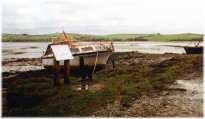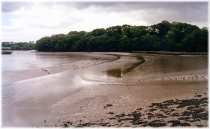

TAMAR ESTUARY
 |
 |
CLASSIFICATION
Part of a much larger SSSl and SPA.
![]()
![]()
TYPE OF HABITAT
Saitmarsh and mudflats covering 404ha.
ACCESS
The foreshore may be reached from Cargreen village (SX 436 627); or at Landulph, follow the lane past the church and turn right through a gate onto a track leading to the sea wall (SX 431 614); the creek may be reached from Moditonham Quay (SX 420 613). All may be approached via lanes from the A388, 2 km (1.25 miles) north of Saltash.
GENERAL DESCRIPTION
The Tamar Estuary is an extensive wetland at the margins of the land and the sea. It is of great national and international wildlife conservation importance, with 1,441 hectares of its area designated as a Site of Special Scientific Interest. Sections of the estuary around Landulph and Cargreen between high and low water are leased to the Cornwall Wildlife Trust by the Duchy of Cornwall.
The mixing of fresh water with salt water produces a mosaic of habitats. Saltmarsh is surrounded by tidal mudflats and rocky shore. These areas provide a valuable haven for wintering wildfowl and waders.
SPECIES OF PARTICULAR INTEREST
The mudflats are of international importance for waterfowl. An abundance of estuarine invertebrate animals, notably molluscs, crustaceans and worms, live in the mud and are a source of much of the richness of the estuarine ecosystem. Fish and many of the important waterfowl that use the estuary feed on these animals.
The estuary supports a nationally important wintering population of avocet. The avocet wades through shallow water and, with its delicately upturned bill, skims tiny animals from the surface layers of the water and mud. The first birds arrive in October and leave again during March.
Shelduck nest in burrows near to the saltmarsh and on the farmland close to the feeding areas. Other regular wintering ducks on the Tamar Estuary are teal and wigeon. Kingfishers are often seen as a blue streak darting across the surface of the water on the river and in the sheltered inlets of the estuary. They feed on small fish which are caught when the birds drop onto them from above, either from a perch or from the air.
Passage or wintering wading birds which use the Tamar Estuary at times for feeding and roosting include black-tailed godwit, curlew, dunlin, redshank and whimbrel. Large numbers of golden plover and lapwing use the estuary, especially during spells of cold weather.